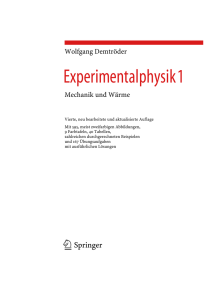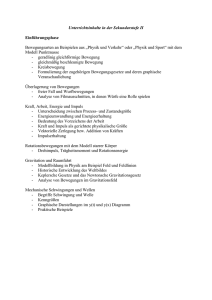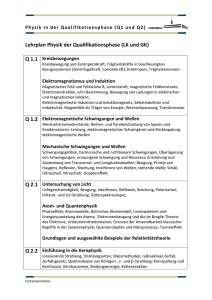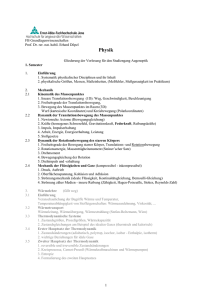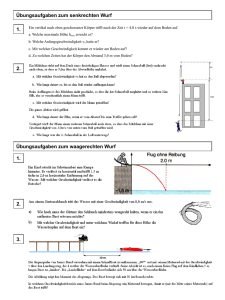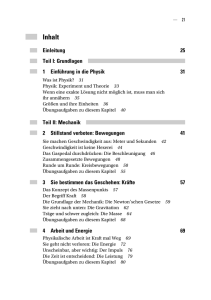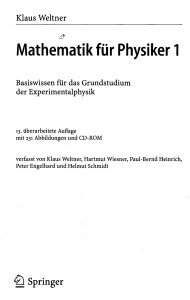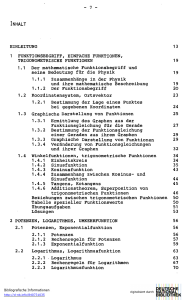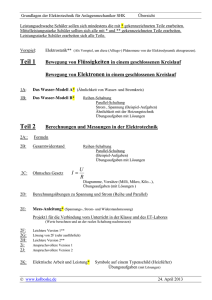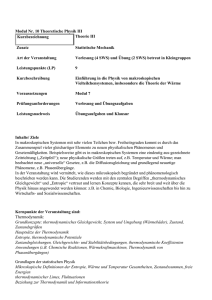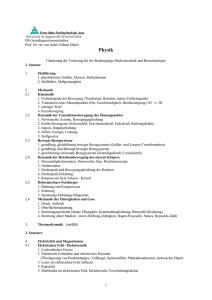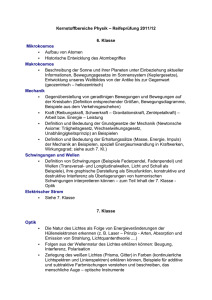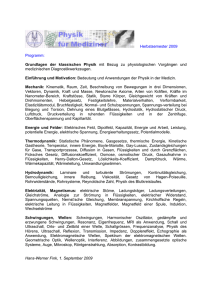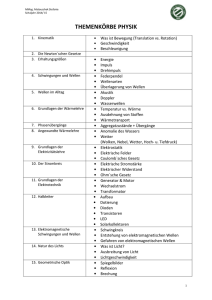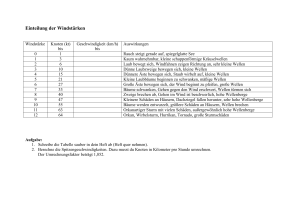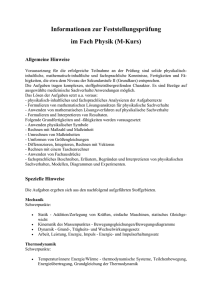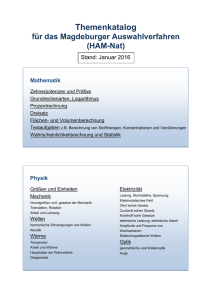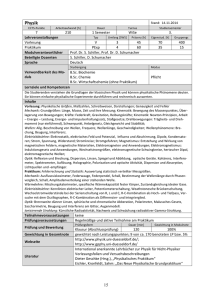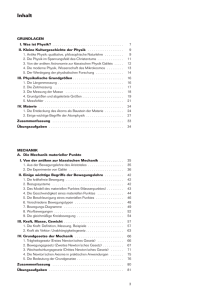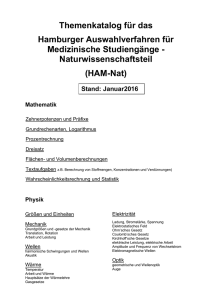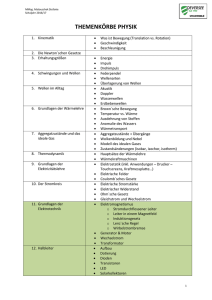Inhaltsverzeichnis
Werbung
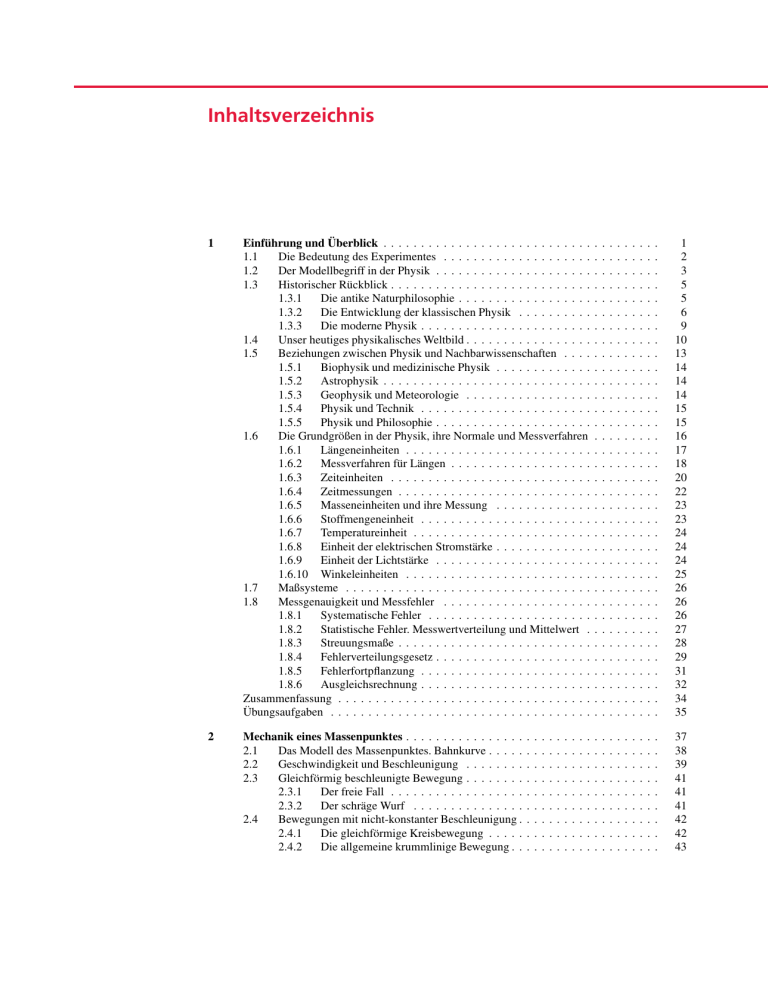
Inhaltsverzeichnis 1 Einführung und Überblick . . . . . . . . . . . . . . . . . . . . . . . . . . . . 1.1 Die Bedeutung des Experimentes . . . . . . . . . . . . . . . . . . . . 1.2 Der Modellbegriff in der Physik . . . . . . . . . . . . . . . . . . . . . 1.3 Historischer Rückblick . . . . . . . . . . . . . . . . . . . . . . . . . . . 1.3.1 Die antike Naturphilosophie . . . . . . . . . . . . . . . . . . 1.3.2 Die Entwicklung der klassischen Physik . . . . . . . . . . 1.3.3 Die moderne Physik . . . . . . . . . . . . . . . . . . . . . . . 1.4 Unser heutiges physikalisches Weltbild . . . . . . . . . . . . . . . . . 1.5 Beziehungen zwischen Physik und Nachbarwissenschaften . . . . 1.5.1 Biophysik und medizinische Physik . . . . . . . . . . . . . 1.5.2 Astrophysik . . . . . . . . . . . . . . . . . . . . . . . . . . . . 1.5.3 Geophysik und Meteorologie . . . . . . . . . . . . . . . . . 1.5.4 Physik und Technik . . . . . . . . . . . . . . . . . . . . . . . 1.5.5 Physik und Philosophie . . . . . . . . . . . . . . . . . . . . . 1.6 Die Grundgrößen in der Physik, ihre Normale und Messverfahren 1.6.1 Längeneinheiten . . . . . . . . . . . . . . . . . . . . . . . . . 1.6.2 Messverfahren für Längen . . . . . . . . . . . . . . . . . . . 1.6.3 Zeiteinheiten . . . . . . . . . . . . . . . . . . . . . . . . . . . 1.6.4 Zeitmessungen . . . . . . . . . . . . . . . . . . . . . . . . . . 1.6.5 Masseneinheiten und ihre Messung . . . . . . . . . . . . . 1.6.6 Stoffmengeneinheit . . . . . . . . . . . . . . . . . . . . . . . 1.6.7 Temperatureinheit . . . . . . . . . . . . . . . . . . . . . . . . 1.6.8 Einheit der elektrischen Stromstärke . . . . . . . . . . . . . 1.6.9 Einheit der Lichtstärke . . . . . . . . . . . . . . . . . . . . . 1.6.10 Winkeleinheiten . . . . . . . . . . . . . . . . . . . . . . . . . 1.7 Maßsysteme . . . . . . . . . . . . . . . . . . . . . . . . . . . . . . . . . 1.8 Messgenauigkeit und Messfehler . . . . . . . . . . . . . . . . . . . . 1.8.1 Systematische Fehler . . . . . . . . . . . . . . . . . . . . . . 1.8.2 Statistische Fehler. Messwertverteilung und Mittelwert . 1.8.3 Streuungsmaße . . . . . . . . . . . . . . . . . . . . . . . . . . 1.8.4 Fehlerverteilungsgesetz . . . . . . . . . . . . . . . . . . . . . 1.8.5 Fehlerfortpflanzung . . . . . . . . . . . . . . . . . . . . . . . 1.8.6 Ausgleichsrechnung . . . . . . . . . . . . . . . . . . . . . . . Zusammenfassung . . . . . . . . . . . . . . . . . . . . . . . . . . . . . . . . . . Übungsaufgaben . . . . . . . . . . . . . . . . . . . . . . . . . . . . . . . . . . . . . . . . . . . . . . . . . . . . . . . . . . . . . . . . . . . . . . . . . . . . . . . . . . . . . . . . . . . . . . . . . . . . . . . . . . . . . . . . . . . . . . . . . . . . . . . . . . . . . . . . . . . . . . . . . . . . . . . . . . . . . . . . . . . . . . . . . . . . . . . . . . . . . . . . . . . . . . . . . . . . . . . . . . . . . . . . . . . . . . . . . . . . . . . . . . . . . . . . . . . . . . . . . . . . . . . . . . . . . . . . . . . . . . . . . . . . . . . . . . . . . . . . . . . . . . . . . . . . . . . . . . . . . . . . . . . . . . . . . . . . . . . . . . . . . . . . . . . . . . . . . . . . . . . . . . . . . . 1 2 3 5 5 6 9 10 13 14 14 14 15 15 16 17 18 20 22 23 23 24 24 24 25 26 26 26 27 28 29 31 32 34 35 2 Mechanik eines Massenpunktes . . . . . . . . . . . . . . . . 2.1 Das Modell des Massenpunktes. Bahnkurve . . . . . 2.2 Geschwindigkeit und Beschleunigung . . . . . . . . 2.3 Gleichförmig beschleunigte Bewegung . . . . . . . . 2.3.1 Der freie Fall . . . . . . . . . . . . . . . . . . 2.3.2 Der schräge Wurf . . . . . . . . . . . . . . . 2.4 Bewegungen mit nicht-konstanter Beschleunigung . 2.4.1 Die gleichförmige Kreisbewegung . . . . . 2.4.2 Die allgemeine krummlinige Bewegung . . . . . . . . . . . . . . . . . . . . . . . . . . . . . . . . . . . . . . . . . . . . . . . . . . . . . . . . . . . . . . . . . . . . . . . . . . . . . . . . . . . 37 38 39 41 41 41 42 42 43 . . . . . . . . . . . . . . . . . . . . . . . . . . . . . . . . . . . . . . . . . . . . . . . . . . . . . . . . . . . . . . . . . . . . . . . . . . . . . . . . . X Inhaltsverzeichnis 2.5 Kräfte . . . . . . . . . . . . . . . . . . . . . . . . . . . . . . . . . . . 2.5.1 Kräfte als Vektoren. Addition von Kräften . . . . . . . 2.5.2 Kraftfelder . . . . . . . . . . . . . . . . . . . . . . . . . . . 2.5.3 Messung von Kräften. Diskussion des Kraftbegriffes . 2.6 Die Grundgleichungen der Mechanik . . . . . . . . . . . . . . . . 2.6.1 Die Newtonschen Axiome . . . . . . . . . . . . . . . . . 2.6.2 Träge und schwere Masse . . . . . . . . . . . . . . . . . 2.6.3 Die Bewegungsgleichung eines Teilchens in einem beliebigen Kraftfeld . . . . . . . . . . . . . . . 2.7 Der Energiesatz der Mechanik . . . . . . . . . . . . . . . . . . . . 2.7.1 Arbeit und Leistung . . . . . . . . . . . . . . . . . . . . . 2.7.2 Wegunabhängige Arbeit. Konservative Kraftfelder . . 2.7.3 Potentielle Energie . . . . . . . . . . . . . . . . . . . . . . 2.7.4 Der Energiesatz der Mechanik . . . . . . . . . . . . . . 2.7.5 Zusammenhang zwischen Kraftfeld und Potential . . . 2.8 Drehimpuls und Drehmoment . . . . . . . . . . . . . . . . . . . . 2.9 Gravitation und Planetenbewegungen . . . . . . . . . . . . . . . . 2.9.1 Die Keplerschen Gesetze . . . . . . . . . . . . . . . . . . 2.9.2 Newtons Gravitationsgesetz . . . . . . . . . . . . . . . . 2.9.3 Planetenbahnen . . . . . . . . . . . . . . . . . . . . . . . . 2.9.4 Das effektive Potential . . . . . . . . . . . . . . . . . . . 2.9.5 Gravitationsfeld ausgedehnter Körper . . . . . . . . . . 2.9.6 Experimentelle Prüfung des Gravitationsgesetzes . . . 2.9.7 Experimentelle Bestimmung der Erdbeschleunigung . Zusammenfassung . . . . . . . . . . . . . . . . . . . . . . . . . . . . . . . . Übungsaufgaben . . . . . . . . . . . . . . . . . . . . . . . . . . . . . . . . . . . . . . . . . . . . . . . . . . . . . . . . . . . . . . . . . . . . . . . . . . . . . . . . . . . . . . . . . . . . . . . . . . . . . . . . . . . . . . 45 45 46 48 49 49 51 . . . . . . . . . . . . . . . . . . . . . . . . . . . . . . . . . . . . . . . . . . . . . . . . . . . . . . . . . . . . . . . . . . . . . . . . . . . . . . . . . . . . . . . . . . . . . . . . . . . . . . . . . . . . . . . . . . . . . . . . . . . . . . . . . . . . . . . . . . . . . . . . . . . . . . . . . . . . . . . . . . . . . . . . . . . . . . . . . . . . . . . . . . . . . . . . . . . . . . 51 54 54 56 57 59 59 60 62 62 64 64 67 67 70 71 73 74 3 Bewegte Bezugssysteme und spezielle Relativitätstheorie 3.1 Relativbewegung . . . . . . . . . . . . . . . . . . . . . . 3.2 Inertialsysteme und Galilei-Transformation . . . . . . 3.3 Beschleunigte Bezugssysteme, Trägheitskräfte . . . . 3.3.1 Geradlinig beschleunigte Bezugssysteme . . 3.3.2 Rotierende Bezugssysteme . . . . . . . . . . . 3.3.3 Zentrifugal- und Corioliskräfte . . . . . . . . 3.3.4 Zusammenfassung . . . . . . . . . . . . . . . . 3.4 Die Konstanz der Lichtgeschwindigkeit . . . . . . . . 3.5 Lorentz-Transformationen . . . . . . . . . . . . . . . . . 3.6 Spezielle Relativitätstheorie . . . . . . . . . . . . . . . . 3.6.1 Das Problem der Gleichzeitigkeit . . . . . . . 3.6.2 Minkowski-Diagramme . . . . . . . . . . . . . 3.6.3 Skalenlängen . . . . . . . . . . . . . . . . . . . 3.6.4 Lorentz-Kontraktion von Längen . . . . . . . 3.6.5 Zeitdilatation . . . . . . . . . . . . . . . . . . . 3.6.6 Zwillings-Paradoxon . . . . . . . . . . . . . . 3.6.7 Raumzeit-Ereignisse und Kausalität . . . . . Zusammenfassung . . . . . . . . . . . . . . . . . . . . . . . . . . Übungsaufgaben . . . . . . . . . . . . . . . . . . . . . . . . . . . . . . . . . . . . . . . . . . . . . . . . . . . . . . . . . . . . . . . . . . . . . . . . . . . . . . . . . . . . . . . . . . . . . . . . . . . . . . . . . . . . . . . . . . . . . . . . . . . . . . . . . . . . . . . . . . . . . . . . . . . . . . . . . . . . . . . . . . . . . . . . . . . . . . . . . . . . . . . . . . . . . . . . . . . . . . . . . . . . . . . . . . . . . . . . . . . . . . . . . . . . . . . . . . . . . . . . . . . . . . . . . . . . . . . . . . . . . . . . . . . . . . . . . . . . . . . . . . . . . . . . . . . . . . . . . . . . . . . . . . . . . . . . . . . . . . . . . . . . . . . . . . . . . . . . . . . . . . . . . . . . . . . . . . . . . . . . . . . . . . . 77 78 78 79 79 81 83 86 86 87 89 89 90 91 92 93 95 97 98 99 4 Systeme von Massenpunkten. Stöße . . . . . . . . . . . . 4.1 Grundbegriffe . . . . . . . . . . . . . . . . . . . . . . 4.1.1 Massenschwerpunkt . . . . . . . . . . . . . 4.1.2 Reduzierte Masse . . . . . . . . . . . . . . 4.1.3 Drehimpuls eines Teilchensystems . . . . 4.2 Stöße zwischen zwei Teilchen . . . . . . . . . . . . 4.2.1 Grundgleichungen . . . . . . . . . . . . . . 4.2.2 Elastische Stöße im Laborsystem . . . . . 4.2.3 Elastische Stöße im Schwerpunktsystem . . . . . . . . . . . . . . . . . . . . . . . . . . . . . . . . . . . . . . . . . . . . . . . . . . . . . . . . . . . . . . . . . . . . . . . . . . . . . . . . . . . . . . . . . . . . . . . . . . . . . . . . . . . . . . . . . . . . . . . . . . . . . . . . . . . . . . . . . . . . . . . . . . . . . . . . . 101 102 102 103 104 106 106 107 109 . . . . . . . . . . . . . . . . . . Inhaltsverzeichnis 4.2.4 Inelastische Stöße . . . . . . . . . . . . . . . . . . . 4.2.5 Newton-Diagramme . . . . . . . . . . . . . . . . . . 4.3 Was lernt man aus der Untersuchung von Stößen? . . . . . 4.3.1 Streuung in einem kugelsymmetrischen Potential 4.3.2 Reaktive Stöße . . . . . . . . . . . . . . . . . . . . . 4.4 Stöße bei relativistischen Energien . . . . . . . . . . . . . . 4.4.1 Relativistische Massenzunahme . . . . . . . . . . . 4.4.2 Kraft und relativistischer Impuls . . . . . . . . . . 4.4.3 Die relativistische Energie . . . . . . . . . . . . . . 4.4.4 Inelastische Stöße bei relativistischen Energien . 4.4.5 Relativistischer Energiesatz . . . . . . . . . . . . . 4.5 Erhaltungssätze . . . . . . . . . . . . . . . . . . . . . . . . . . 4.5.1 Impulserhaltungssatz . . . . . . . . . . . . . . . . . 4.5.2 Energieerhaltungssatz . . . . . . . . . . . . . . . . . 4.5.3 Drehimpulserhaltung . . . . . . . . . . . . . . . . . 4.5.4 Erhaltungssätze und Symmetrien . . . . . . . . . . Zusammenfassung . . . . . . . . . . . . . . . . . . . . . . . . . . . . . Übungsaufgaben . . . . . . . . . . . . . . . . . . . . . . . . . . . . . . . . . . . . . . . . . . . . . . . . . . . . . . . . . . . . . . . . . . . . . . . . . . . . . . . . . . . . . . . . . . . . . . . . . . . . . . . . . . . . . . . . . . . . . . . . . . . . . . . . . . . . . . . . . . . . . . . . . . . . . . . . . . . . . . . . . . . . . . . . . . . . . . . . . . . . . . . . . . . . . . . . . . . . . . . . . . . . . . . . . . . . . . . . . . . . . . . . . . . . . . . . . . . . . . . . . . . . . . . . . . . . . . . . . . . . . . . . . . . . . . . . . . . . . . . . . . 111 113 114 114 117 118 118 119 120 121 122 123 123 123 123 123 125 125 5 Dynamik starrer ausgedehnter Körper . . . . . . . . . . . . . . . . . . 5.1 Das Modell des starren Körpers . . . . . . . . . . . . . . . . . . . 5.2 Massenschwerpunkt . . . . . . . . . . . . . . . . . . . . . . . . . . 5.3 Die Bewegung eines starren Körpers . . . . . . . . . . . . . . . . 5.4 Kräfte und Kräftepaare . . . . . . . . . . . . . . . . . . . . . . . . . 5.5 Trägheitsmoment und Rotationsenergie . . . . . . . . . . . . . . 5.5.1 Steinerscher Satz . . . . . . . . . . . . . . . . . . . . . . . 5.6 Bewegungsgleichung der Rotation eines starren Körpers . . . . 5.6.1 Rotation um eine Achse bei konstantem Drehmoment 5.6.2 Drehschwingungen um eine feste Achse . . . . . . . . 5.6.3 Vergleich von Translation und Rotation . . . . . . . . . 5.7 Rotation um freie Achsen; Kreiselbewegungen . . . . . . . . . . 5.7.1 Trägheitstensor und Trägheitsellipsoid . . . . . . . . . 5.7.2 Hauptträgheitsmomente . . . . . . . . . . . . . . . . . . . 5.7.3 Freie Achsen . . . . . . . . . . . . . . . . . . . . . . . . . 5.7.4 Die Eulerschen Gleichungen . . . . . . . . . . . . . . . 5.7.5 Der kräftefreie symmetrische Kreisel . . . . . . . . . . 5.7.6 Präzession des symmetrischen Kreisels . . . . . . . . . 5.7.7 Überlagerung von Nutation und Präzession . . . . . . . 5.8 Die Erde als symmetrischer Kreisel . . . . . . . . . . . . . . . . . Zusammenfassung . . . . . . . . . . . . . . . . . . . . . . . . . . . . . . . . Übungsaufgaben . . . . . . . . . . . . . . . . . . . . . . . . . . . . . . . . . . . . . . . . . . . . . . . . . . . . . . . . . . . . . . . . . . . . . . . . . . . . . . . . . . . . . . . . . . . . . . . . . . . . . . . . . . . . . . . . . . . . . . . . . . . . . . . . . . . . . . . . . . . . . . . . . . . . . . . . . . . . . . . . . . . . . . . . . . . . . . . . . . . . . . . . . . . . . . . . . . . . . . . . . . . . . . . . . . . . . . . . . . . . . . . . . . . . . . . . . . . . . . . . . . . . . . . . . . . . . . . . . . . . . . . . . . . . . . . . . . . 127 128 128 129 130 132 132 135 136 137 138 138 138 140 142 143 143 146 147 148 150 151 6 Reale feste und flüssige Körper . . . . . . . . . . . . . . . . . . . . . . . . . . 6.1 Atomares Modell der Aggregatzustände . . . . . . . . . . . . . . . . . 6.2 Deformierbare feste Körper . . . . . . . . . . . . . . . . . . . . . . . . . 6.2.1 Hookesches Gesetz . . . . . . . . . . . . . . . . . . . . . . . . 6.2.2 Querkontraktion . . . . . . . . . . . . . . . . . . . . . . . . . . 6.2.3 Scherung und Torsionsmodul . . . . . . . . . . . . . . . . . . 6.2.4 Biegung eines Balkens . . . . . . . . . . . . . . . . . . . . . . 6.2.5 Elastische Hysterese, Deformationsarbeit . . . . . . . . . . . 6.2.6 Die Härte eines Festkörpers . . . . . . . . . . . . . . . . . . . 6.3 Ruhende Flüssigkeiten, Hydrostatik . . . . . . . . . . . . . . . . . . . . 6.3.1 Freie Verschiebbarkeit und Oberflächen von Flüssigkeiten 6.3.2 Statischer Druck in einer Flüssigkeit . . . . . . . . . . . . . . 6.3.3 Auftrieb und Schwimmen . . . . . . . . . . . . . . . . . . . . . . . . . . . . . . . . . . . . . . . . . . . . . . . . . . . . . . . . . . . . . . . . . . . . . . . . . . . . . . . . . . . . . . . . . . . . . . . . . . . . . . . . . . . . . . . . . . . . . . . . . . . . 153 154 156 156 157 158 159 161 162 163 163 163 166 XI XII Inhaltsverzeichnis 6.4 Phänomene an Flüssigkeitsgrenzflächen . . . . . 6.4.1 Oberflächenspannung . . . . . . . . . . . 6.4.2 Grenzflächen und Haftspannung . . . . 6.4.3 Kapillarität . . . . . . . . . . . . . . . . . 6.4.4 Zusammenfassung . . . . . . . . . . . . . 6.5 Reibung zwischen festen Körpern . . . . . . . . . 6.5.1 Haftreibung . . . . . . . . . . . . . . . . . 6.5.2 Gleitreibung . . . . . . . . . . . . . . . . . 6.5.3 Rollreibung . . . . . . . . . . . . . . . . . 6.5.4 Bedeutung der Reibung in der Technik 6.6 Die Erde als deformierbarer Körper . . . . . . . . 6.6.1 Polabplattung der rotierenden Erde . . . 6.6.2 Gezeitenverformung . . . . . . . . . . . . 6.6.3 Wirkungen der Gezeiten . . . . . . . . . 6.6.4 Messung der Erdverformung . . . . . . Zusammenfassung . . . . . . . . . . . . . . . . . . . . . . . Übungsaufgaben . . . . . . . . . . . . . . . . . . . . . . . . . . . . . . . . . . . . . . . . . . . . . . . . . . . . . . . . . . . . . . . . . . . . . . . . . . . . . . . . . . . . . . . . . . . . . . . . . . . . . . . . . . . . . . . . . . . . . . . . . . . . . . . . . . . . . . . . . . . . . . . . . . . . . . . . . . . . . . . . . . . . . . . . . . . . . . . . . . . . . . . . . . . . . . . . . . . . . . . . . . . . . . . . . . . . . . . . . . . . . . . . . . . . . . . . . . . . . . . . . . . . . . . . . . . . . . . . . . . . . . . . . . . . . . . . . . . . . . . . . . . . . . . . . . . . . . . . . . . . . . . . . . . . . . . . . . . . . . . . . . . . . . . . . . . . . . . . . . . . . . . . . . . . . . . . . . . . . . . . . . . . 167 167 169 171 172 172 172 173 174 175 176 176 177 180 180 182 182 ........................................ Makroskopische Betrachtung . . . . . . . . . . . . . . . . . . . . . Luftdruck und barometrische Höhenformel . . . . . . . . . . . . Kinetische Gastheorie . . . . . . . . . . . . . . . . . . . . . . . . . 7.3.1 Das Modell des idealen Gases . . . . . . . . . . . . . . . 7.3.2 Grundgleichungen der kinetischen Gastheorie . . . . . 7.3.3 Mittlere kinetische Energie und absolute Temperatur . 7.3.4 Verteilungsfunktion . . . . . . . . . . . . . . . . . . . . . 7.3.5 Maxwell-Boltzmannsche Geschwindigkeitsverteilung 7.3.6 Stoßquerschnitt und mittlere freie Weglänge . . . . . . 7.4 Experimentelle Prüfung der kinetischen Gastheorie . . . . . . . 7.4.1 Molekularstrahlen . . . . . . . . . . . . . . . . . . . . . . 7.5 Transportprozesse in Gasen . . . . . . . . . . . . . . . . . . . . . . 7.5.1 Diffusion . . . . . . . . . . . . . . . . . . . . . . . . . . . . 7.5.2 Brownsche Bewegung . . . . . . . . . . . . . . . . . . . . 7.5.3 Wärmeleitung in Gasen . . . . . . . . . . . . . . . . . . . 7.5.4 Viskosität von Gasen . . . . . . . . . . . . . . . . . . . . 7.5.5 Zusammenfassung . . . . . . . . . . . . . . . . . . . . . . 7.6 Die Erdatmosphäre . . . . . . . . . . . . . . . . . . . . . . . . . . . Zusammenfassung . . . . . . . . . . . . . . . . . . . . . . . . . . . . . . . . Übungsaufgaben . . . . . . . . . . . . . . . . . . . . . . . . . . . . . . . . . 7 Gase . 7.1 7.2 7.3 . . . . . . . . . . . . . . . . . . . . . . . . . . . . . . . . . . . . . . . . . . . . . . . . . . . . . . . . . . . . . . . . . . . . . . . . . . . . . . . . . . . . . . . . . . . . . . . . . . . . . . . . . . . . . . . . . . . . . . . . . . . . . . . . . . . . . . . . . . . . . . . . . . . . . . . . . . . . . . . . . . . . . . . . . . . . . . . . . . . . . . . . . . . . . . . . . . . . . . . . . . . . . . . . . . . . . . . . . . . . . . . . . . . . . . . 185 186 187 189 189 189 190 191 192 196 197 197 199 200 202 203 204 205 206 208 208 8 Strömende Flüssigkeiten und Gase . . . . . . . . . . . . . . . . . . . . . . 8.1 Grundbegriffe und Strömungstypen . . . . . . . . . . . . . . . . . . 8.2 Euler-Gleichung für ideale Flüssigkeiten . . . . . . . . . . . . . . . 8.3 Kontinuitätsgleichung . . . . . . . . . . . . . . . . . . . . . . . . . . 8.4 Bernoulli-Gleichung . . . . . . . . . . . . . . . . . . . . . . . . . . . 8.5 Laminare Strömungen . . . . . . . . . . . . . . . . . . . . . . . . . . 8.5.1 Innere Reibung . . . . . . . . . . . . . . . . . . . . . . . . . 8.5.2 Laminare Strömung zwischen zwei parallelen Wänden 8.5.3 Laminare Strömungen durch Rohre . . . . . . . . . . . . 8.5.4 Kugelfall-Viskosimeter, Stokessches Gesetz . . . . . . . 8.6 Navier-Stokes-Gleichung . . . . . . . . . . . . . . . . . . . . . . . . 8.6.1 Wirbel und Zirkulation . . . . . . . . . . . . . . . . . . . . 8.6.2 Helmholtzsche Wirbelsätze . . . . . . . . . . . . . . . . . 8.6.3 Die Entstehung von Wirbeln . . . . . . . . . . . . . . . . . 8.6.4 Turbulente Strömungen; Strömungswiderstand . . . . . . . . . . . . . . . . . . . . . . . . . . . . . . . . . . . . . . . . . . . . . . . . . . . . . . . . . . . . . . . . . . . . . . . . . . . . . . . . . . . . . . . . . . . . . . . . . . . . . . . . . . . . . . . . . . . . . . . . . . . . . . . . . . . . . . . . . . . . . . . . . . . . . . . . . . . 211 212 214 214 216 219 219 221 222 223 223 224 226 226 228 Inhaltsverzeichnis 8.7 Aerodynamik . . . . . . . . . . . . . . . . . . . . . . . . . . . . . 8.7.1 Der dynamische Auftrieb . . . . . . . . . . . . . . . . 8.7.2 Zusammenhang zwischen dynamischem Auftrieb und Strömungswiderstand . . . . . . . . . . . . . . . 8.7.3 Kräfte beim Fliegen . . . . . . . . . . . . . . . . . . . 8.8 Ähnlichkeitsgesetze; Reynolds’sche Zahl . . . . . . . . . . . 8.9 Nutzung der Windenergie . . . . . . . . . . . . . . . . . . . . . Zusammenfassung . . . . . . . . . . . . . . . . . . . . . . . . . . . . . . Übungsaufgaben . . . . . . . . . . . . . . . . . . . . . . . . . . . . . . . . . . . . . . . . . . . . . . . . . . . . . . . . . . . . . . . . . . . . . . . . . . . . . . . . . . . . . . . . . . . . . . . . . . . . . . . . . . . . . 231 232 232 233 237 238 9 Vakuum-Physik . . . . . . . . . . . . . . . . . . . . . . . . . . . . 9.1 Grundlagen und Grundbegriffe . . . . . . . . . . . . . . . 9.1.1 Die verschiedenen Vakuumbereiche . . . . . . 9.1.2 Einfluss der Wandbelegung . . . . . . . . . . . 9.1.3 Saugvermögen und Saugleistung von Pumpen 9.1.4 Strömungsleitwerte von Vakuumleitungen . . 9.1.5 Erreichbarer Enddruck . . . . . . . . . . . . . . 9.2 Vakuumerzeugung . . . . . . . . . . . . . . . . . . . . . . 9.2.1 Mechanische Pumpen . . . . . . . . . . . . . . . 9.2.2 Diffusionspumpen . . . . . . . . . . . . . . . . . 9.2.3 Kryo- und Sorptionspumpen . . . . . . . . . . . 9.3 Messung kleiner Drücke . . . . . . . . . . . . . . . . . . . 9.3.1 Flüssigkeitsdruckmessgeräte . . . . . . . . . . . 9.3.2 Membranmanometer . . . . . . . . . . . . . . . 9.3.3 Wärmeleitungsmanometer . . . . . . . . . . . . 9.3.4 Ionisations- und Penning-Vakuummeter . . . . 9.3.5 Reibungsvakuummeter . . . . . . . . . . . . . . Zusammenfassung . . . . . . . . . . . . . . . . . . . . . . . . . . . Übungsaufgaben . . . . . . . . . . . . . . . . . . . . . . . . . . . . . . . . . . . . . . . . . . . . . . . . . . . . . . . . . . . . . . . . . . . . . . . . . . . . . . . . . . . . . . . . . . . . . . . . . . . . . . . . . . . . . . . . . . . . . . . . . . . . . . . . . . . . . . . . . . . . . . . . . . . . . . . . . . . . . . . . . . . . . . . . . . . . . . . . . . . . . . . . . . . . . . . . . . . . . . . . . . . . . . . . . . . . . . . . . . . . . . . . . . . . . . . . . . . . . . . . . . . . . . . . . . . . . . . . . . . . . . . . . . . . . . . . . . . 239 240 240 241 242 242 243 244 244 247 249 250 251 251 252 253 253 254 254 10 Wärmelehre . . . . . . . . . . . . . . . . . . . . . . . . . . . . . . . . . . . . . 10.1 Temperatur und Wärmeenergie . . . . . . . . . . . . . . . . . . . . . . 10.1.1 Temperaturmessung, Thermometer und Temperaturskala 10.1.2 Thermische Ausdehnung fester und flüssiger Körper . . . 10.1.3 Thermische Ausdehnung von Gasen, Gasthermometer . . 10.1.4 Absolute Temperaturskala . . . . . . . . . . . . . . . . . . . 10.1.5 Wärmemenge und spezifische Wärme . . . . . . . . . . . . 10.1.6 Molvolumen und Avogadro-Konstante . . . . . . . . . . . 10.1.7 Innere Energie und molare Wärmekapazität idealer Gase 10.1.8 Spezifische Wärme eines Gases bei konstantem Druck . 10.1.9 Molekulare Deutung der spezifischen Wärme . . . . . . . 10.1.10 Spezifische Wärmekapazität fester Körper . . . . . . . . . 10.1.11 Schmelzwärme und Verdampfungswärme . . . . . . . . . 10.2 Wärmetransport . . . . . . . . . . . . . . . . . . . . . . . . . . . . . . . 10.2.1 Konvektion . . . . . . . . . . . . . . . . . . . . . . . . . . . . 10.2.2 Wärmeleitung . . . . . . . . . . . . . . . . . . . . . . . . . . . 10.2.3 Das Wärmerohr (Heatpipe) . . . . . . . . . . . . . . . . . . 10.2.4 Methoden der Wärmeisolierung . . . . . . . . . . . . . . . . 10.2.5 Wärmestrahlung . . . . . . . . . . . . . . . . . . . . . . . . . 10.2.6 Thermische Solarenergienutzung . . . . . . . . . . . . . . . 10.3 Die Hauptsätze der Thermodynamik . . . . . . . . . . . . . . . . . . 10.3.1 Zustandsgrößen . . . . . . . . . . . . . . . . . . . . . . . . . . 10.3.2 Der erste Hauptsatz der Thermodynamik . . . . . . . . . . 10.3.3 Spezielle Prozesse als Beispiele für den ersten Hauptsatz 10.3.4 Der zweite Hauptsatz der Thermodynamik . . . . . . . . . 10.3.5 Der Carnotsche Kreisprozess . . . . . . . . . . . . . . . . . 10.3.6 Äquivalente Formulierungen des zweiten Hauptsatzes . . . . . . . . . . . . . . . . . . . . . . . . . . . . . . . . . . . . . . . . . . . . . . . . . . . . . . . . . . . . . . . . . . . . . . . . . . . . . . . . . . . . . . . . . . . . . . . . . . . . . . . . . . . . . . . . . . . . . . . . . . . . . . . . . . . . . . . . . . . . . . . . . . . . . . . . . . . . . . . . . . . . . . . . . . . . . . . . . . . . . . . . . . . . . . . . . . . . . . . . . . . . . . . . . . . . . . . . . . . . . . . . . . . . . . . . . . . . . . . . . . . . . 257 258 258 260 263 264 264 266 266 267 267 269 270 271 271 272 276 277 279 284 286 286 287 288 289 290 293 . . . . . . . . . . . . . . . . . . . . . . . . . . . . . . . . . . . . . . . . . . . . . . . . . . . . . . . . . . . . . . . . . . . . . . 229 . . . . . . . . . . . . . 229 XIII XIV Inhaltsverzeichnis 10.3.7 10.3.8 10.3.9 10.3.10 10.3.11 Die Entropie . . . . . . . . . . . . . . . . . . . Reversible und irreversible Prozesse . . . . . Freie Energie und Enthalpie . . . . . . . . . . Chemische Reaktionen . . . . . . . . . . . . . Thermodynamische Potentiale; Zusammenhang zwischen Zustandsgrößen . 10.3.12 Gleichgewichts-Zustände . . . . . . . . . . . . 10.3.13 Der dritte Hauptsatz (Nernstsches Theorem) 10.3.14 Thermodynamische Maschinen . . . . . . . . 10.4 Thermodynamik realer Gase und Flüssigkeiten . . . . 10.4.1 Van-der-Waalssche Zustandsgleichung . . . 10.4.2 Stoffe in verschiedenen Aggregatzuständen 10.4.3 Lösungen und Mischzustände . . . . . . . . . 10.5 Vergleich der verschiedenen Zustandsänderungen . . 10.6 Energiequellen und Energie-Umwandlung . . . . . . . 10.6.1 Wasserkraftwerke . . . . . . . . . . . . . . . . 10.6.2 Gezeitenkraftwerke . . . . . . . . . . . . . . . 10.6.3 Wellenkraftwerk . . . . . . . . . . . . . . . . . 10.6.4 Geothermie-Kraftwerke . . . . . . . . . . . . . 10.6.5 Solar-thermische Kraftwerke . . . . . . . . . 10.6.6 Photovoltaik Anlagen . . . . . . . . . . . . . . 10.6.7 Bio-Energie . . . . . . . . . . . . . . . . . . . . 10.6.8 Energiespeicher . . . . . . . . . . . . . . . . . Zusammenfassung . . . . . . . . . . . . . . . . . . . . . . . . . . Übungsaufgaben . . . . . . . . . . . . . . . . . . . . . . . . . . . 11 . . . . . . . . . . . . . . . . . . . . . . . . . . . . . . . . . . . . . . . . . . . . . . . . . . . . . . . . . . . . . . . . . . . . 294 297 298 299 . . . . . . . . . . . . . . . . . . . . . . . . . . . . . . . . . . . . . . . . . . . . . . . . . . . . . . . . . . . . . . . . . . . . . . . . . . . . . . . . . . . . . . . . . . . . . . . . . . . . . . . . . . . . . . . . . . . . . . . . . . . . . . . . . . . . . . . . . . . . . . . . . . . . . . . . . . . . . . . . . . . . . . . . . . . . . . . . . . . . . . . . . . . . . . . . . . . . . . . . . . . . . . . . . . . . . . . . . . . . . . . . . . . . . . . . . . . . . . . . . . . . . . . . . . . . . . . . . . . . . . . . . . . . . . . . . . . . . . . . . . . . . . . . . . . . . . . . . . . . . . . . . . . . . . . . . . . . . . . . . . . . . . . . . . . . . . . . . . . . 300 300 301 303 306 306 308 314 316 316 318 318 319 319 320 321 321 321 323 324 Mechanische Schwingungen und Wellen . . . . . . . . . . . . . . . . . . . . . 11.1 Der freie ungedämpfte Oszillator . . . . . . . . . . . . . . . . . . . . . . 11.2 Darstellung von Schwingungen . . . . . . . . . . . . . . . . . . . . . . . 11.3 Überlagerung von Schwingungen . . . . . . . . . . . . . . . . . . . . . . 11.3.1 Eindimensionale Überlagerungen . . . . . . . . . . . . . . . . . 11.3.2 Zweidimensionale Überlagerung, Lissajous-Figuren . . . . . 11.4 Der freie gedämpfte Oszillator . . . . . . . . . . . . . . . . . . . . . . . . 11.4.1 < !0 , d. h. schwache Dämpfung . . . . . . . . . . . . . . . . 11.4.2 > !0 , d. h. starke Dämpfung . . . . . . . . . . . . . . . . . . 11.4.3 D !0 (aperiodischer Grenzfall) . . . . . . . . . . . . . . . . 11.5 Erzwungene Schwingungen . . . . . . . . . . . . . . . . . . . . . . . . . . 11.5.1 Stationärer Zustand . . . . . . . . . . . . . . . . . . . . . . . . . 11.5.2 Einschwingvorgang . . . . . . . . . . . . . . . . . . . . . . . . . 11.6 Energiebilanz bei der Schwingung eines Massenpunktes . . . . . . . . 11.7 Parametrischer Oszillator . . . . . . . . . . . . . . . . . . . . . . . . . . . 11.8 Gekoppelte Oszillatoren . . . . . . . . . . . . . . . . . . . . . . . . . . . . 11.8.1 Gekoppelte Federpendel . . . . . . . . . . . . . . . . . . . . . . 11.8.2 Erzwungene Schwingungen zweier gekoppelter Pendel . . . 11.8.3 Normalschwingungen . . . . . . . . . . . . . . . . . . . . . . . . 11.9 Mechanische Wellen . . . . . . . . . . . . . . . . . . . . . . . . . . . . . . 11.9.1 Verschiedene Darstellungen harmonischer ebener Wellen . . 11.9.2 Zusammenfassung . . . . . . . . . . . . . . . . . . . . . . . . . . 11.9.3 Allgemeine Darstellung beliebiger Wellen. Wellengleichung 11.9.4 Verschiedene Wellentypen . . . . . . . . . . . . . . . . . . . . . 11.9.5 Ausbreitung von Wellen in verschiedenen Medien . . . . . . 11.9.6 Energiedichte und Energietransport in einer Welle . . . . . . 11.9.7 Dispersion, Phasen- und Gruppengeschwindigkeit . . . . . . 11.10 Überlagerung von Wellen . . . . . . . . . . . . . . . . . . . . . . . . . . . 11.10.1 Kohärenz und Interferenz . . . . . . . . . . . . . . . . . . . . . . 11.10.2 Überlagerung zweier harmonischer Wellen . . . . . . . . . . . . . . . . . . . . . . . . . . . . . . . . . . . . . . . . . . . . . . . . . . . . . . . . . . . . . . . . . . . . . . . . . . . . . . . . . . . . . . . . . . . . . . . . . . . . . . . . . . . . . . . . . . . . . . . . . . . . . . . . . . . . . . . . . . . . . . . . . . . . . . . . . . . . . . . . . . . . . . . . . . . . . . . . . . . . . . . . . . . . . . . . . . . . . . . . . . . . . . . . . . . . . . . . . . . . . 325 326 327 328 328 331 333 333 334 334 335 336 338 338 339 341 341 342 343 344 345 346 346 347 350 355 355 357 357 358 Inhaltsverzeichnis 11.11 Beugung, Reflexion und Brechung von Wellen . . . . . . . . . . . . 11.11.1 Huygenssches Prinzip . . . . . . . . . . . . . . . . . . . . . . 11.11.2 Beugung an Begrenzungen . . . . . . . . . . . . . . . . . . . 11.11.3 Zusammenfassung . . . . . . . . . . . . . . . . . . . . . . . . 11.11.4 Reflexion und Brechung von Wellen . . . . . . . . . . . . . 11.12 Stehende Wellen . . . . . . . . . . . . . . . . . . . . . . . . . . . . . . . 11.12.1 Eindimensionale stehende Wellen . . . . . . . . . . . . . . 11.12.2 Experimentelle Demonstration stehender Wellen . . . . . 11.12.3 Zweidimensionale Eigenschwingungen von Membranen 11.13 Wellen bei bewegten Quellen . . . . . . . . . . . . . . . . . . . . . . . 11.13.1 Doppler-Effekt . . . . . . . . . . . . . . . . . . . . . . . . . . 11.13.2 Wellenfronten bei bewegten Quellen . . . . . . . . . . . . . 11.13.3 Stoßwellen . . . . . . . . . . . . . . . . . . . . . . . . . . . . . 11.14 Akustik . . . . . . . . . . . . . . . . . . . . . . . . . . . . . . . . . . . . 11.14.1 Definitionen . . . . . . . . . . . . . . . . . . . . . . . . . . . . 11.14.2 Druckamplitude und Energiedichte von Schallwellen . . 11.14.3 Erzeugung von Schallwellen . . . . . . . . . . . . . . . . . . 11.14.4 Schalldetektoren . . . . . . . . . . . . . . . . . . . . . . . . . 11.14.5 Ultraschall . . . . . . . . . . . . . . . . . . . . . . . . . . . . . 11.14.6 Anwendungen des Ultraschalls . . . . . . . . . . . . . . . . 11.14.7 Verfahren der Ultraschalldiagnostik . . . . . . . . . . . . . 11.15 Physik der Musikinstrumente . . . . . . . . . . . . . . . . . . . . . . . 11.15.1 Einteilung der Musikinstrumente . . . . . . . . . . . . . . . 11.15.2 Akkorde, Tonleitern und Stimmungen . . . . . . . . . . . . 11.15.3 Physik der Geige . . . . . . . . . . . . . . . . . . . . . . . . . 11.15.4 Physik beim Klavierspiel . . . . . . . . . . . . . . . . . . . . Zusammenfassung . . . . . . . . . . . . . . . . . . . . . . . . . . . . . . . . . . Übungsaufgaben . . . . . . . . . . . . . . . . . . . . . . . . . . . . . . . . . . . . . . . . . . . . . . . . . . . . . . . . . . . . . . . . . . . . . . . . . . . . . . . . . . . . . . . . . . . . . . . . . . . . . . . . . . . . . . . . . . . . . . . . . . . . . . . . . . . . . . . . . . . . . . . . . . . . . . . . . . . . . . . . . . . . . . . . . . . . . . . . . . . . . . . . . . . . . . . . . . . . . . . . . . . . . . . . . . . . . . . . . . . . . . . . . . . . . . . . . . . . . . . . . . . . . . . . . . . . . . . . . . . . . . . . . . . . . . . . . . . . . . . . . . . . . . . 360 360 361 362 362 364 364 365 366 368 368 369 370 371 371 372 373 373 374 375 375 376 377 377 379 380 381 383 12 Nichtlineare Dynamik und Chaos . . . . . . . . . . . . . . . . . . . 12.1 Stabilität dynamischer Systeme . . . . . . . . . . . . . . . . . 12.2 Logistisches Wachstumsgesetz und Feigenbaum-Diagramm 12.3 Parametrischer Oszillator . . . . . . . . . . . . . . . . . . . . . 12.4 Bevölkerungsexplosion . . . . . . . . . . . . . . . . . . . . . . 12.5 Systeme mit verzögerter Rückkopplung . . . . . . . . . . . . 12.6 Selbstähnlichkeit . . . . . . . . . . . . . . . . . . . . . . . . . . 12.7 Fraktale . . . . . . . . . . . . . . . . . . . . . . . . . . . . . . . . 12.8 Mandelbrot-Mengen . . . . . . . . . . . . . . . . . . . . . . . . 12.9 Folgerungen für unser Weltverständnis . . . . . . . . . . . . . Zusammenfassung . . . . . . . . . . . . . . . . . . . . . . . . . . . . . . Übungsaufgaben . . . . . . . . . . . . . . . . . . . . . . . . . . . . . . . . . . . . . . . . . . . . . . . . . . . . . . . . . . . . . . . . . . . . . . . . . . . . . . . . . . . . . . . . . . . . . . . . . . . . . . . . . . . . . . . . . . . . . . . . . . . . . . . . . . . . . . . . . . . . . . . . . . . . . . . . . . . . . . . . . . . . . . . . . . . . . . . . . . . . . . . . . . . 385 387 391 393 394 395 396 397 398 401 401 402 13 Anhang . . . . . . . . . . . . . . . . . . . . . . . . . . . . . . . . . 13.1 Vektorrechnung . . . . . . . . . . . . . . . . . . . . . . . 13.1.1 Definition des Vektors . . . . . . . . . . . . . . 13.1.2 Darstellung von Vektoren . . . . . . . . . . . 13.1.3 Polare und axiale Vektoren . . . . . . . . . . . 13.1.4 Addition von Vektoren . . . . . . . . . . . . . 13.1.5 Multiplikation von Vektoren . . . . . . . . . . 13.1.6 Differentiation von Vektoren . . . . . . . . . . 13.2 Koordinatensysteme . . . . . . . . . . . . . . . . . . . . 13.2.1 Kartesische Koordinaten . . . . . . . . . . . . 13.2.2 Zylinderkoordinaten . . . . . . . . . . . . . . . 13.2.3 Sphärische Koordinaten (Kugelkoordinaten) . . . . . . . . . . . . . . . . . . . . . . . . . . . . . . . . . . . . . . . . . . . . . . . . . . . . . . . . . . . . . . . . . . . . . . . . . . . . . . . . . . . . . . . . . . . . . . . . . . . . . . . . . . . . . . . . . . . . . . . . . . . . . . . . . . . . . . . . . . . . . . . . . . . . . . . . . . . . 403 404 404 404 405 405 406 407 410 410 410 411 . . . . . . . . . . . . . . . . . . . . . . . . . . . . . . . . . . . . . . . . . . . . . . . . XV XVI Inhaltsverzeichnis 13.3 13.4 14 Komplexe Zahlen . . . . . . . . . . . . . . . . . 13.3.1 Rechenregeln für komplexe Zahlen . 13.3.2 Polardarstellung . . . . . . . . . . . . Fourieranalyse . . . . . . . . . . . . . . . . . . . . . . . . . . . . . . . . . . . . . . . . . . . . . . . . . . . . . . . . . . . . . . . . . . . . . . . . . . . . . . . . . . . . . . . . . . . . . . . . . . . . . . . . . . . 412 413 413 414 Lösungen der Übungsaufgaben . . . . . . . . . . . . . . . . . . . . . . . . . . . . . . . . . . 415 Farbtafeln . . . . . . . . . . . . . . . . . . . . . . . . . . . . . . . . . . . . . . . . . . . . . . . . . . . . 447 Literaturverzeichnis . . . . . . . . . . . . . . . . . . . . . . . . . . . . . . . . . . . . . . . . . . . . . . 455 Sachverzeichnis . . . . . . . . . . . . . . . . . . . . . . . . . . . . . . . . . . . . . . . . . . . . . . . . . 461
